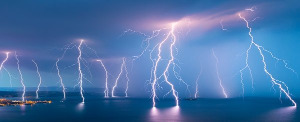
An international research team led by the University of Groningen has used the Low Frequency Array (LOFAR) radio to study the development of lightning flashes and why they often strike twice.
LOFAR is a radio telescope made of thousands of simple antennas all over Northern Europe. These antennas are all controlled through fiber-optic cables that allow them to connect with a central computer. LOFAR is used for radio astronomy observations, but the frequency range of the antennas makes it suitable for lightning research as well. Their new studies analyzed raw time-traces where Brian Hare with the center for Advanced Radiation Technology at Groningen said, “These data allow us to detect lightning propagation at a scale where, for the first time, we can distinguish the primary processes. Furthermore, the use of radio waves allows us to look inside the thundercloud, where most lightning resides.”
Lightning is formed by strong upward air currents inside clouds where some parts of the cloud become charged with positive or negative energy. When a separation of the charges becomes large enough, a violent discharge occurs known as lightning. The discharge starts with plasma, a small area of ionized hot air, hot enough to be electrically conductive and it can reach lengths of several kilometers. Positive tips from the plasma channel collect negative charges, which pass through the channel to the negative tip. This triggers another lightning discharge once again. The needles along the lightning bolt can have a length of around 100 meters and a diameter of less than five meters. However, these needles are too small and disappear quickly before lightning detection systems can recognize them.
Recently, scientists have created a new method allowing them to visualize the very high frequency (VHF) from two lightning flashes. Professor Scholten said, “Close to the core area of LOFAR, where the antenna density is highest, the spatial accuracy was about one meter.” This resulted in a good quality 3D image of the lightning discharge. The result answered their question on why lightning strikes twice. Their results, clearly showed a break in the discharge channel from where the needles were located and they appeared to have an outbreak of negative charges from the main channel. Once the charges in the cloud are high enough to discharge, the second lightning bolt discharges out of the cloud.
Professor Joe Dwyer of the University of New Hampshire said, “Our new observation techniques show copious amounts of needles in the lightning flash, which have not been seen before.” Brian Hare concluded, “From these observations, we see that a part of the cloud is re-charged, and we can understand why a lightning discharge to the ground may repeat itself a few times.”
[Source:
Science daily.com
]

